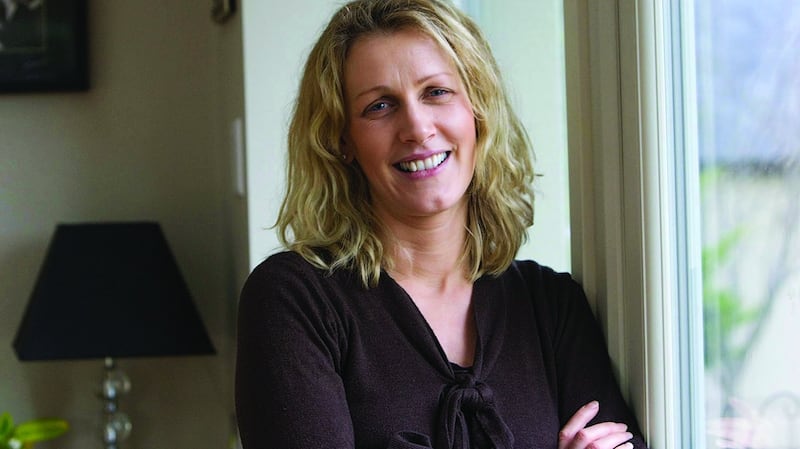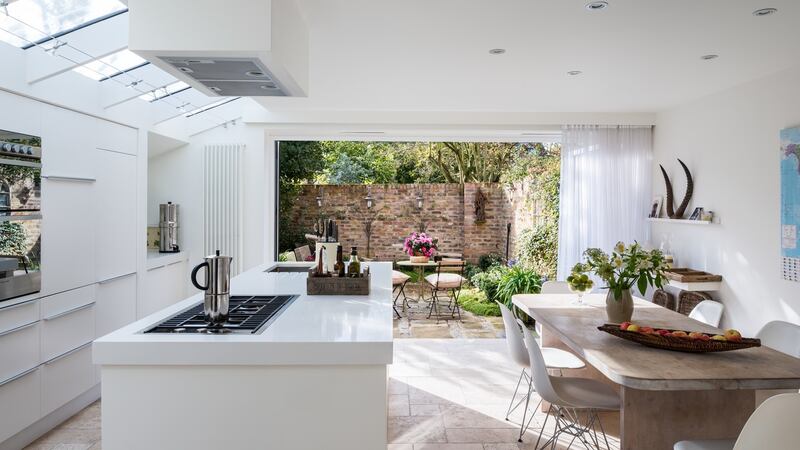Patricia Power is the no-nonsense quantity surveyor who made her name on the RTÉ show Room To Improve, the ying to presenter Dermot Bannon's yang.
She left the show in January and has been swamped with work because her ability to talk money makes her invaluable to any building job.
Power’s main piece of advise to anyone embarking on home improvements is to spend money in ways that add to comfort levels – so money that is outlayed on insulation and new windows will make your home a much nicer space to live in and will reduce your utility bills. Keep in mind that a good-looking kitchen, no matter how cool it is, will still date, she says. And once you start building works, there is a knock-on effect. If you decide to get the builders in, have a think about what else it affects, can you do the work bit by bit, or is it worth saving some more to do more in the long run?
For Declan O'Donnell, the sage judge on the last couple of series of RTÉ's other popular property show, Home of the Year, who has also left the show, the most luxurious way to do renovations is to invest in the fabric of the house and to create light and a sense of space within it.
The two experts have outlined the main building queries they get below. This, they say, is money well spent because it adds to the overall comfort levels of your house, and will, over time, save you in energy bills.
After this dirty work is done, what remains in the budget can be spent on the niceties such as fitting a new kitchen, new bathroom ware, tiling and painting.

So what’s involved in getting my home insulated?
You can dry-line a house internally using insulation board but you need to remember to factor in monies to replaster and paint the walls, the coving and the skirting afterwards, says Power.
“If you are insulating, that is the time to do any rewiring and plumbing pipework because your radiators are probably on external walls and will need to be removed when dry-lining.
“Insulation board is a synthetic material. Sheep wool is a natural alternative that you would sandwich behind studded walls. It costs a little bit less than the synthetic options but won’t help improve your BER to the same degree as the synthetic.
“A house that is over 60 years’ old will probably have lime plaster and will need a breathable solution that is three times the price of the standard insulation.”
If I’m on a tight budget, what kind of windows should I go for?
“On a project, the cost uplift between double- and triple-glazing is well worth the extra spend over their lifetime because the level of comfort achieved with triple-glazing is far superior to that of double. Triple-glazing is a must on north-facing walls and while the process makes the glazing slightly grey in colour, we live in what is a cold, damp and grey climate. The experiential difference is phenomenal. But don’t just consider the glass. Consider the window as a whole. Go for full replacement of the glass and frames, as you lose heat through both,” advises Power.
She says architects aren’t mad on Upvc windows because they’re not a natural material but they are effective and can be ordered in any RAL colour, for an additional cost. Aluclad windows are another option and its timber-effect interior can be painted to co-ordinate with any colour scheme.
I’m told I need to rewire. What can I expect?
Rewiring is pretty disruptive, says Power. “If you’re insulating internally, rewire at the same time. You will need to work out your lighting plan in advance to instruct your electrician where you want all sockets and light points to go. You can never have enough sockets. A five-amp socket in rooms like the living room, master bedroom and even a child’s room means you can illuminate table lamps from one flick of the main switch – instead of having to go round and manually switch each one on. It is a very effective and inexpensive way to layer light.
“Also factor in security wiring for windows, doors and roof lights as well as CCTV wiring and even an external port for an electric car.”
What should expect if I also need to replumb?
Plumbing is dirty, messy, horrible work, Power says. “If the boiler is more than 10 years’ old it will also need upgrading. You may need new radiators too. It is worth reading about the SEAI grants available. The areas to invest in include heating controls that create zones within the house, hot water and heating separate.”
The avocado suite has got to go. How much will that cost me?
“A new bathroom can cost between €8,000 and €10,000 depending on the level of fixtures and fittings you go for,” says Power. “An ensuite will cost a bit less. A power shower, the kind that features monsoon and rain water heads, will use more electricity and water than an electric shower. When costing, factor in new sanitaryware (go for the smaller cisterns that use less water), tiles for floors, showers and sink surrounds and taps.”
Do you really need an extension?
“We’re conditioned to think about extensions when many houses are already plenty big but their layout needs a rethink,” says O’Donnell. “If the client loves to cook and the front reception gets bathed in morning light then why not install the kitchen in one of the best rooms in the house instead of out the back where it doesn’t have the same aspect?”

How much will it cost me?
“When you’re thinking about renovations, there are any number of great visual resources to tap into but what you really need is expert advice that can help you put figures on what you’d like to do,” says O’Donnell. “That’s where a well-seasoned architect and quantity surveyor can help save you money.
“A rule of thumb is you should expect to pay between €1,000 and €1,500 per square metre to renovate an existing house. That money should, first and foremost, go into the fabric of the house.”
“Expect to pay from €3,000 to €4,000 per square metre for new build works – that includes extensions.
“In the current market, much of the housing stock being offered for sale needs upgrading and sometimes you may be better off choosing a wreck of a house that has no heating over one that appears to be in good order but is already 25 to 30 or more years’ old, for the latter will still need heating and electrical upgrades, is Power’s advice. “The better option is an older house in rag order that you haven’t paid a premium for.”
Make a list and check it twice
The first thing you need to do is make a list of everything you want to put into the refurb, is O’Donnell’s advice. “Most clients underestimate what everything costs. Itemise every single element, however small – floors, sanitaryware, kitchen units, appliances, tiles for floors, walls and splashbacks, windows, flooring, every aspect of the lighting right down to the light switches. Put it all into a spreadsheet and start putting a price on each. By the time you’ve added these up, you will realise that some compromises will have to be made to deliver the job you want done within the budget that you have.”
What am I paying for?
The best money you can spend is on a good architect, O’Donnell says. “He or she will draft proper documents and drawings for the design and planning stages, create detailed documents for tender so that every aspect has been considered and by doing so you create a sort of shopping list for the builder. These then become your contract documents. If it’s not on the tender document then you can’t get it priced.
“Architect fees are generally between 10 and 14 per cent of the build costs. There are some that offer a package service where they will do a survey and draft plans for you and equip you with a list of reputable suppliers and contractors to execute the works.”
What is your budget?
While professionals like architects and quantity surveyors can give you a read on building materials, you, the client, need to have an overall financial picture of what you have to spend, O’Donnell says. “To get that, you need to know what everything will cost. Do you want to spend €5,000 or €50,000 on a kitchen? You need to figure out what can you actually afford to spend.
“Costs spiral when you’ve budgeted €90 per square metre for flooring and you want a beautiful parquet for €300 per square metre.
“You should talk budget at every stage, from your first meeting to drafting drawings for planning and through the build.”

AHHH I hate it. What can I do to change it?
Making changes after services have been installed is going to cost money, says O’Donnell.
“A so-called small job may not be as small as you think. Even a small kitchen extension will still require foundations, wiring, plumbing, structural steelwork, the physical units, nice countertops, flooring, lighting, sliding doors out to the garden, a new bathroom under the stairs, a roof and roof finishes and maybe a new garden to look out at.”
Is it really as bad as most people make out?
It is really stressful, O’Donnell says. “Don’t put yourself in the financial situation where your back is against the wall. Until the build gets out of the ground, keep about €8,000 as a contingency.”
Join Patricia Power and Declan O'Donnell at The Irish Times Home & Design Theatre at the Ideal Homes Show this Friday and Saturday.
Budget breakdown
I have €100,000 to do all renovation works. I’m living in a standard-size three-bedroom semi. Can you give me an idea of how I should spend it?
Insulation to floor, walls and attic: €15,000
Window and door replacement: €20,000
Electrical re-wiring: €9,000
Re-plumbing, pipework, radiators, new hot water cylinder: €18,000
Kitchen: €10,000
Bathroom/en-suite works: €12,000
New internal doors, ironmongery: €3,000
Flooring: €6,500
Decoration: €5,000
Wardrobes: €1,500
Budget spend €100,000
Grants
Be aware of the grants available – the SEAI better energy home scheme covers grants for insulation and heating upgrade works; also under the Home Renovation Incentive, window replacement, re-wiring, plastering, tiling, new kitchens, bathrooms and painting qualify.
Bear in mind that your property tax needs to be paid up to date and that any invoices submitted need to be in the same name as is on property tax payments.

















